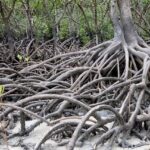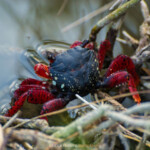In many parts of the world, mangroves have long been frowned upon as dirty, mosquito-infested tangles of roots that stand in the way of an ocean view. - Andrew Kolb, 2016 in 6 facts you need to know about mangroves
Page Contents
Background
What are mangroves?
Mangroves are the only species of flowering trees in the world that can tolerate living in saltwater.
Though estimates vary, there are at least 50 — and maybe up to 110 — mangrove species, ranging in height from 2 to 30 meters. Red mangroves, black mangroves, and white mangroves are three of the most common types. Because of the limited fresh water available in salty intertidal soils, mangroves have adaptations to conserve water. These include a thick waxy skin on the leaf or dense hairs to reduce evaporation of water. Most evaporation loss occurs through pores in the leaves - so these are often sunken below the leaf surface where they are protected from drying winds. Leaves are also commonly succulent, storing water in fleshy internal tissue. They also vary the orientation of their leaves to avoid the harsh midday sun and so reduce evaporation from the leaves.
Mangroves have special adaptations that allow them to cope with salt levels and fluctuations in water availability that would kill other angiosperms. Mangrove mud is low in oxygen and different species cope with this in a variety of ways. Red mangroves prop themselves above the water level with stilt roots and can then absorb air through pores in their bark. Black mangroves live on higher ground and have large numbers of pneumatophores (specialised root-like structures which stick up out of the soil like straws for breathing) which are also covered in pores. These pneumatophores can reach heights of up to thirty centimetres, and in some species, over three metres. Other root adaptations include the buttress roots and knee roots.
Mangrove distribution

Mangrove trees grow in dense thickets in intertidal zones and estuary mouths between land and sea. Typically they are found in tropical, subtropical and some temperate regions along the coasts of over 120 tropical and subtropical countries, occupying approximately 14 to 15 million hectares. The majority of mangroves are found on the coasts of Southeast Asia, Brazil, parts of the African coast and Northern Australia.
Salt levels in the mud can increase significantly due to evaporation of water at low tide. Some of this salt may be flushed out when the tide returns but mangroves need to be able to cope with higher salinity levels than most plants. Red mangroves exclude salt by having significantly impermeable (not allowing fluid to pass through) roots which act as a filtration system. Analysis of water inside mangroves has shown 90% to 97% of salt has been excluded at the roots.
Salt which does accumulate in the shoot, concentrates in old leaves and bark which the plant then sheds. Red mangroves can also store salt in cell vacuoles (a space within enclosed by a membrane often containing fluid). White mangroves can secrete salts directly; they have two salt glands at each leaf base. Some mangroves use only one of these methods but many use two or more.
Mangrove ecology
Mangroves are keystone members of the ecosystem. Mangroves, specifically the underwater habitat their roots provide, offer critical nursing environments for juveniles of thousands of fish and invertebrates species.
Services
As you can see in the image provided, mangroves are very generous in the services that they provide for us. Another metric for carbon storage capacity of mangrove swamps -
1 hectare of mangroves can offset the emissions of burning of 726 tonnes of coal.
Mangroves are also capable of storing extremely toxic heavy metals such as nickel, chromium and copper in their roots, essentially locking them out of the wider environment.
Mangrove forest also provide habitat for many other species e.g. crabs, fish, prawns, birds and some mammals. The roots act as shelter for young fish and invertebrates. As one example of their economic importance in the food industry, about 75% of the fish and prawns caught for commercial and recreational purposes in Queensland, Australia spend at least part of their lifecycles in mangroves.
The Black Mangrove is used for making fishing poles, and in the production of honey, as the blossoms give the honey a unique flavour. Because the wood gives off an intense heat, it is especially prized for burning clay from which bricks are produced. Also their fruits are edible, and most mangrove bark produces high quality tannin which is suitable for tanning leather. The indigenous people of several countries use extracts from mangrove plants as valuable sources of dyes.
Cultural contributions
Mangrove forests also have cultural significance for many indigenous people who live in their vicinity. For example, in Australia, for thousands of years mangroves have been an important resource for Aboriginal and Torres Strait Islander people. Many materials were gathered from mangroves and continue to have high cultural significance. Mangrove timber has been used in the construction of artifacts such canoes, paddles, spears and boomerangs, and traditional medicines have been derived from certain types of mangroves. Plus mangrove forest areas have been used as training grounds to teach children about natural resource management.
People visit mangroves forests as ecotourists in order to learn about mangroves first hand and to examine artefacts made by local people using sustainable harvesting practices.
The importance of mangroves has been recognised in postal stamps in Fiji, Mauritius, New Caledonia, Mozambique, Samoa, China, Tanzania, Tuvalu, Wallace&Fortuna, Papua New Guinea, Indonesia, Mexico, Tonga, Sri Lanka, India and Singapore.
Summary of services provided for us
- Removes CO2 from atmosphere - climate change mitigation
- Water filtration
- Provides habitat for other species such as many commercially harvested for food
- Raw materials - wood is useful in making objects, dyes, tannin
- Cultural significance
- Recreational opportunities
Threats to the services?

As well as the threats outlined in the accompanying infographic, mangroves are also threatened by
- life-stock grazing, particularly from goats
- clearing for purely "aesthetic" reasons as some people consider them unattractive
There is work being done to conserve mangrove forest and to make up for some of the damage done e.g. 50 years of data show that Madagascar’s mangroves are making a comeback
What can we do to retain these services?
- Consideration given to impact on mangroves in all relevant development/access/building regulations e.g. keep livestock out of mangrove areas;
design riverfront structures such as jetties or boat ramps to avoid or minimise impacts to mangroves; confine human access to mangrove areas to approved areas e.g. boardwalks - Prohibiting use of mangrove areas as a dumping ground especially for toxic items such as oils and plastics
- Support projects such as the Global Mangrove Alliance, Blue Ventures, Mangrove Watch, The Mangrove Action Project
- Manual restoration projects involving mangrove planting
- Combating existing negative attitudes to mangroves and raising awareness of the mangroves' contributions to us to create political will for funding restoration projects
Dig deeper
- Fact sheet - Mangroves
- Mangrove Forests
- Video Importance of mangrove forests
- Root and branch reform – Protecting and restoring the world’s mangrove forests
- In Lagos, Vulnerable Communities Buried by Urbanization (podcast and transcript)
- In Puerto Rico, a marathon effort builds to restore mangroves and dunes
- Poor planning, persistent farming undermine mangrove restoration in Tanzania
- Mangroves among the most carbon-rich forests in the tropics
- Mangroves - Guardians of the coast
- Could Mangroves Help Save our Planet?
- The world's mangroves 2000-2020 80 page book in .pdf format
- ‘Sundarbans may need 40 years to recover biodiversity losses’
- 50 years of data show that Madagascar’s mangroves are making a comeback
- Flood Protection by Mangroves Saves $855 Billion Globally, 2024 Report Finds














